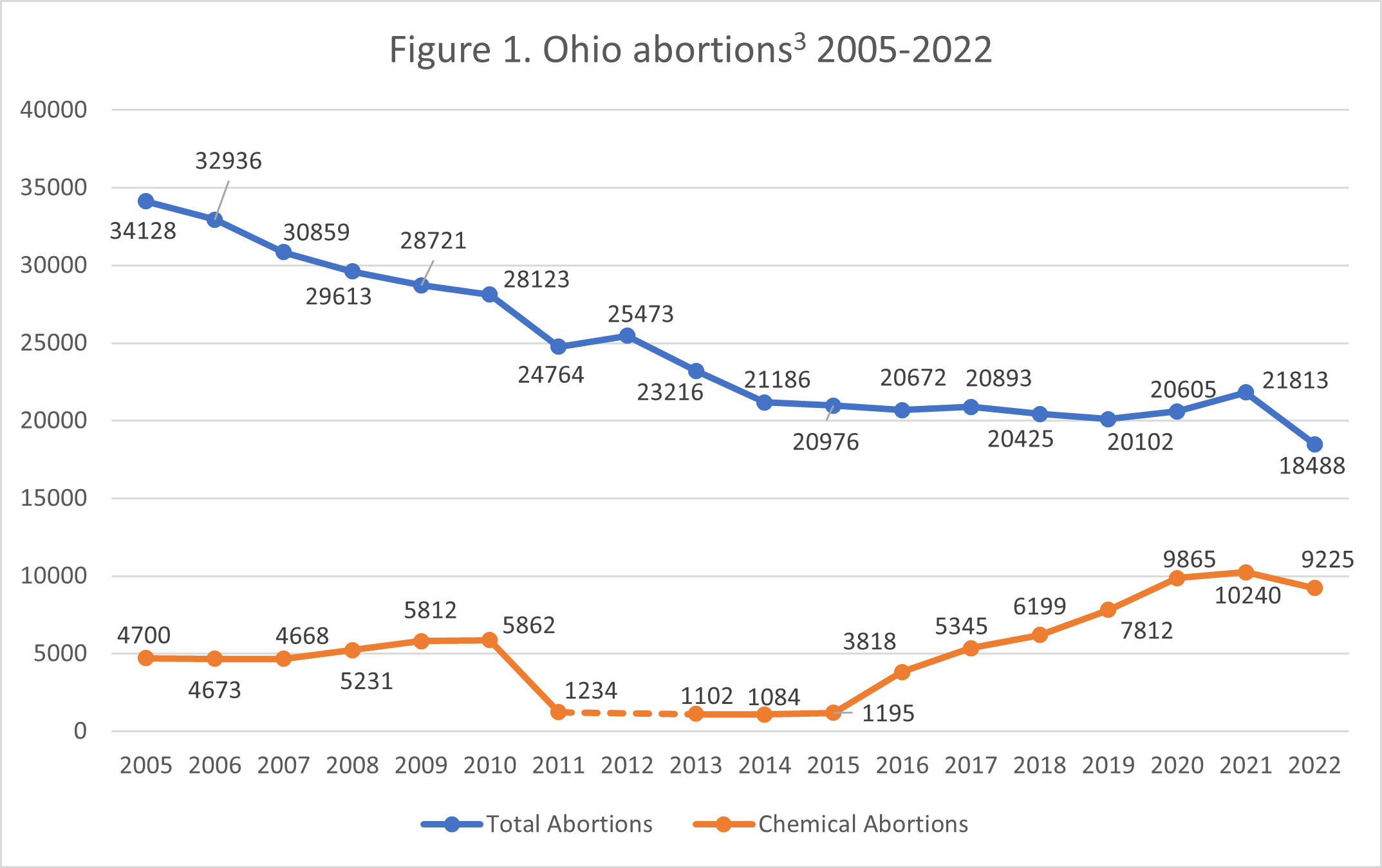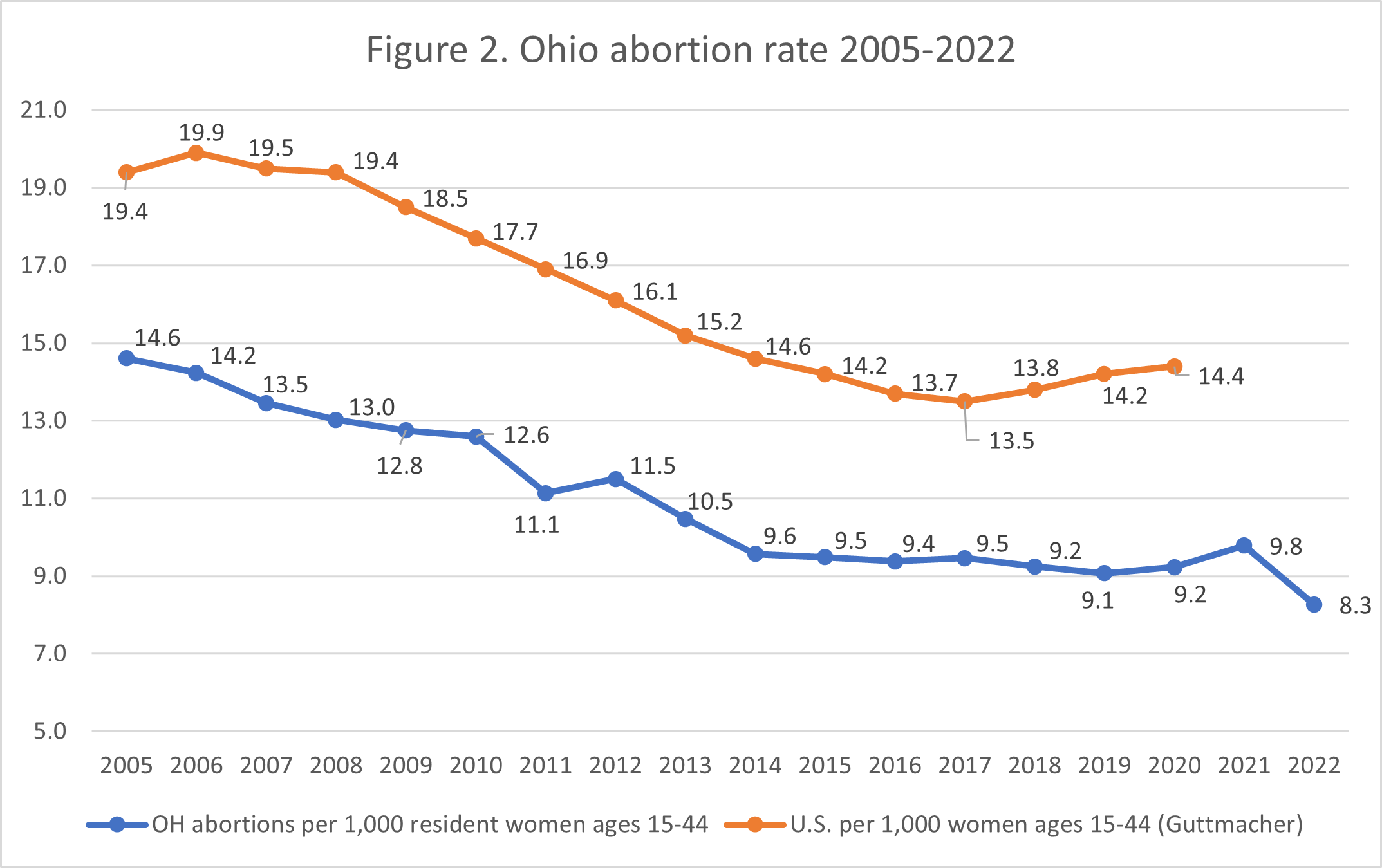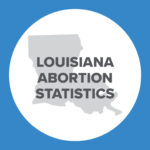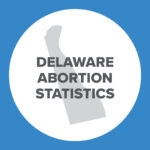Abortion Reporting: Ohio (2022)
Ohio’s 2022 abortion report was published in September 2023 by the Ohio Department of Health. Abortions decreased in the state from 2021.
Statistics and Changes in Ohio Abortions, 2021-2022

This report does not include information on Planned Parenthood’s Ohio abortion market share.
Abortion Totals and Trends
In 2022, there were 18,488 abortions reported in Ohio, a decrease of 15% from 2021 (Fig. 1). Chemical abortions also decreased from the previous year, from 10,240 in 2021 to 9,225 in 2022. Chemical abortions made up half of the state abortion total in 2022. The Charlotte Lozier Institute (CLI) estimates that Ohio’s 2022 abortion rate was 8.3 abortions per 1,000 women of childbearing age, a decrease of 16% (Fig. 2).1 As of October 2023, 23 states have released 2022 abortion reports, of which 10 showed that abortions had decreased from the year before.
State Report Summary
The vast majority of Ohio abortions (93%) were reported to have been performed on resident women, while 7% were obtained by nonresidents. Eight percent of Ohio abortions were performed on girls ages 19 and younger (including 2% on girls under the age of 18), and 58% were performed on women in their twenties, with 29% each on women ages 20 to 24 and women ages 25 to 29. Thirty percent were performed on women in their thirties, and 3% on women ages 40 and older.
Nine percent of Ohio abortions were on women who had not graduated from high school, and 42% on women with a high school diploma or its equivalent as their highest level of education. Twenty-one percent were on women with some college but no degree, and 22% were obtained by women who had received an associate degree or more. Level of education was not reported for 5% of the abortions that occurred in Ohio.
Eighty-two percent of the abortions were obtained by unmarried women, and 11% were performed on married or separated women. Marital status was not reported for 7% of the abortions. Just under one-quarter (24%) of the abortions were on women with no previous pregnancies, 18% were performed on women with one prior pregnancy, and 55% were on women with two or more previous pregnancies. The number of previous pregnancies was unreported for 3% of the abortions.
Fifty-nine percent of the abortions were on women who reported no previous abortions, compared to 22% on women with one prior abortion and 17% on women with two or more abortions. Thirty-four percent of the abortions were conducted on women with no living children, while 25% were on women with one child and 38% on women with more than one. The number of previous abortions and number of living children were not reported for 3% of the women who obtained abortions.
In 2022, 43% of Ohio abortions were performed on black women. Forty-two percent were obtained by white women, and 3% by Asian or Pacific Islander women. Forty-five abortions (0.2%) were on Native American women, and 5% were on women of multiple races. Race was not reported for 7% of the abortions. CLI estimates that the black abortion rate was 23.7 abortions per 1,000 women of childbearing age, five times the white rate of 4.4. Seventy-six percent of Ohio abortions were on non-Hispanic women, while 6% were on Hispanic women, and 18% were on women of unknown ethnicity.
Ohio allows multiple methods to be reported for each abortion. In 2022, there were 18,585 procedures used, compared to the 18,488 abortions reported in the state. Fifty percent of the abortions were chemical. Forty-two percent were performed using suction curettage, and 8% were performed using dilation and evacuation. There were four abortions that used dilation and extraction (the same procedure used in partial-birth abortions), one hysterotomy abortion, and two hysterectomy abortions. Ohio’s partial birth abortion law as well as federal law prohibits the use of dilation and extraction unless the unborn baby is killed prior to being partially born . There were 20 abortions performed using other, unspecified surgical procedures and two abortions performed via an unspecified method.
Sixty-six percent of Ohio abortions occurred at eight weeks of gestation or earlier. Twenty-three percent were performed between nine and 12 weeks, and 9% occurred between 13 and 18 weeks of gestation. One percent were performed between 19 and 20 weeks of gestation, and 105 abortions (0.6%) were performed at 21 weeks or later. More than one method of determining gestational age could be reported for each abortion. Ultrasound was used to estimate gestational age for the majority of abortions (90%), and the last menstrual period was used for 16%. A clinical exam was used in 6% of the cases, while some other means was used to calculate gestational age in four cases.
During a portion of the time period covered by this report (the beginning of 2022 through June 24, 2022 and again from September 15, 2022 through the end of the year), Ohio limited abortion at 22 weeks gestation) except to protect a woman’s life or a major bodily function. Beginning at 19 weeks of gestation, Ohio required that doctors test to see if the unborn baby was viable. Of the 342 abortions performed at 19 weeks or later in 2022, one was performed on a viable baby. Ultrasound was used to determine viability in advance of all 342 abortions. In addition, the babies’ weight was used in four cases, genetic testing in three cases, and amniocentesis and chorionic villus sampling were used in one case each.
In 2022, there were seven abortions performed after 20 weeks post-fertilization (22 weeks of gestation). The report does not indicate the justification for these abortions or if they were performed because the woman’s life or a major bodily function was in danger. Twenty-six women were reported to have a medical condition other than “good” at the time of their abortion, but the report does not state whether any of those women obtained abortions after 20 weeks post-fertilization.
In 2022, 22 abortion reporting forms indicated that the abortion had resulted in complications.2 Multiple complications could be reported for each abortion, and 25 total complications were reported. There were 10 cases of hemorrhage and two cases of both incomplete abortion and hematometra. One infection was reported. Additionally, there were 10 instances of other, unspecified complications.
Ohio also received 136 post-abortion care report forms reporting 140 complications. There were 59 failed abortions (typically referring to ongoing pregnancy) and 40 incomplete abortions (when pieces of the unborn baby or placenta were retained in the uterus). Hematometra occurred 17 times, infection five times, and hemorrhage four times. There were 15 other unspecified complications.
Ohio has an adverse event reporting system for chemical abortions; however, it is separate from the state’s annual abortion report released by the health department. When a complication arises from a chemical abortion, the doctor who administered the abortion drugs must report the complication to the Ohio State Medical Board and the health department.
Fifty-five percent of the abortions were performed on women who said they were not using contraception at the time they became pregnant, while 15% of the abortions were on women who were using contraception. Contraceptive use was not reported for 29%. Contraception was recommended after all the abortions.
Ohio reports the type of counseling provided in advance of an abortion, and women can report having obtained multiple forms of counseling before their abortion. Sixty-two percent of the abortions were performed on women who had received medical counseling, and 17% on women who had received counseling from social services. Psychological counseling was provided before 27 abortions, and pastoral counseling was provided before 19 abortions. Three women received some other form of counseling, while 38% did not receive counseling. Ohio requires that before an abortion is performed on a woman, she must be provided with information about her pregnancy and alternatives to abortion at least 24 hours in advance. However, the report does not include information on this informed consent process.
The majority of Ohio abortions (83%) were performed in ambulatory surgical facilities. Seventeen percent occurred in non-surgical clinics, and 95 abortions were performed in hospitals.
Abortion Data and Ohio’s Heartbeat Law
After Roe v. Wade was overturned on June 24, 2022, Ohio’s heartbeat law (O.R.C. 2919.19-2919.1910) went into effect immediately and remained in effect until September 14, 2022 when it was indefinitely blocked. As CLI has previously summarized, Ohio’s heartbeat law limits abortion after an unborn baby’s heartbeat is detected (typically around six weeks of gestation). Pursuant to this statute and Ohio Administrative Code 3701-47-07, certain reporting requirements related to this law were added to the state’s 2022 confidential abortion reporting form. Data from these new sections was included in the 2022 annual report. There were 1,967 total abortions in the state from June 24, 2022, through September 14, 2022. All but 20 occurred when there was no detection of a fetal heartbeat. Of the 20 abortions that occurred after a fetal heartbeat was detected, all were performed because the mother’s life and/or physical health was endangered by a continued pregnancy. Ohio’s heartbeat law allows exceptions in cases of medical necessity or medical emergency. In 2022, abortions were performed for the following medical reasons: 11 cases of premature rupture of membranes, six cases of “inevitable abortion,” five cases of infection, and four cases of cardiac disease. There were also six other, unspecified conditions that constituted a medical emergency under the heartbeat law.
Other Legislative Changes
In November 2023, Ohioans will vote on Issue 1, a ballot initiative that would add a legalright to abortion to the state’s constitution. If this ballot initiative were to pass, nearly all of the state’s pro-life protections would be invalidated and abortion on demand, up until the moment of birth, would be legal in Ohio.
State Ranking
Ohio’s abortion reports are some of the best nationwide. In 2016, CLI evaluated abortion reporting across the 50 states and Ohio ranked third best. To further improve its reporting, Ohio could include the chemical abortion adverse events report in the annual abortion report the health department publishes. Additionally, Ohio could provide information on its informed consent process.


- National rates were calculated by Guttmacher Institute. Ohio rates were calculated by CLI using the following formula: (total number of abortions performed in Ohio ÷ number of resident women ages 15-44 [based on most recent population estimates]) x 1,000. Rates may differ slightly from previous CLI articles due to revised population estimates. Population estimates were obtained using the CDC WONDER database. Estimates for 2005-2009 are intercensal estimates of the July 1 resident population. Estimates for 2010-2019 are Vintage 2020 postcensal estimates of the July 1 resident population. Estimates for 2020-2022 are Vintage 2022 postcensal estimates of the July 1 resident population. Estimates were produced by the U.S. Census Bureau and the National Center for Health Statistics.
- Statistics on abortion complications reported here represent a minimal number of deaths and complications, as this data is collected in a non-systematic and non-verifiable way. As such, this data cannot be used to calculate either an accurate abortion mortality rate or an accurate abortion complication rate for the state.
- This chart does not contain the number of chemical abortions reported in 2012. Ohio changed its abortion reporting formatting between 2011 and 2021, and the Ohio Department of Health was not able to confirm the number of chemical abortions reported in 2012.



























